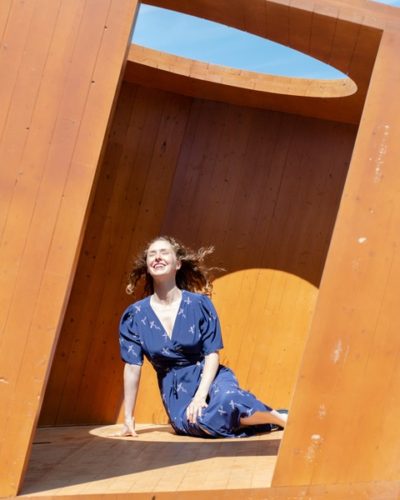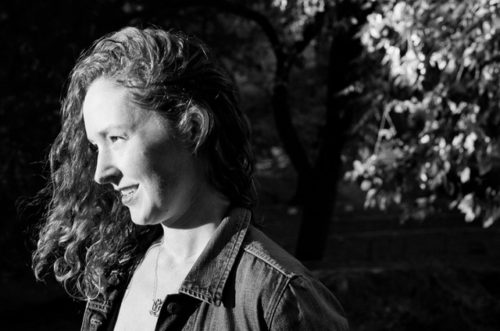
With experience on the stage, in television and films, and as a playwright, Amanda Quaid is a well-versed artist. She has written six plays and screenplays and is in the process of developing her play The Extinctionist into her first opera libretto, which is set to premiere in 2023. Inspired by her deep interest in climate science, coming to terms with climate change has been a prominent theme in some of her works. Acclaimed by many, Amanda has won multiple prizes, including a LUNAFEST prize, for her works, and she shares her insights and skills by teaching actors and singers.
We corresponded with Amanda recently to learn more about how she integrates climate awareness, story-telling, and performance through her work.
ClimateMusic: When and how did you first become interested in climate issues, and how did this evolve into telling stories about climate science and climate change through theater and writing?
AQ: I first became interested in climate after reading Jonathan Safran Foer’s book Eating Animals in 2016. The connection between diet and climate change was something I had never considered before. I became vegetarian, later vegan, and sort of went happily along my way, thinking I was making a difference. But I became interested in larger group movements in 2019, just after I became a mother. The Amazon was on fire, and I think it was at that moment everything clicked together for me. Individual actions are not sufficient. We need to come together as a people and demand wide systemic change.
But activism and art are, to me, totally different expressions of truth. Activism is an expression of certainty and, by virtue of the language of slogans and hashtags, is often dualistic—good vs. evil. Art, on the other hand, is a place for exploring uncertainty, gray area, ambivalence—a space to entertain opposing truths at the same time. I felt a strong need to have both.
ClimateMusic: How do you see writing and theater as a unique vehicle for fostering public climate awareness? To you, what are the arts able to communicate about climate change that science and facts alone cannot?
AQ: Theater and live performance holds unique potential as a storytelling vehicle because of the communal experience of watching it. It’s one thing to see a documentary on Netflix at home, feel an impact, then turn it off and go to bed. But being in a theater audience is different. It’s private, but also social. You’re watching, but you’re also being perceived—by the performers, by fellow audience members. In that way, you’re invited to engage with a piece’s ideas on a different level. I think it also allows us to explore bleak narratives while simultaneously holding each other tight. You know you’re not alone in a theater. There’s hope in that.
We need to be able to humanize statistics, and we need to feel less alone in our own experience. Art can do that. One of the most powerful works I’ve encountered about climate is the Weather Station’s new album Ignorance. It gives voice to fear, nostalgia, hope, denial—these messy emotions we’re all experiencing right now. I don’t listen to it so much for answers, but to sit in the questions for a while with another voice and feel connected in that way.
ClimateMusic: In your play Circumstances Affecting the Heat of the Sun’s Rays, you highlight how Eunice Foote’s identity as a woman affects her perspective and work as a breakthrough climate scientist. How do you see one’s gender and other identities influencing their participation in the climate movement?
AQ: I would send anyone interested in this question straight to Ayana Elizabeth Johnson and Katharine K. Wilkinson’s excellent book All We Can Save: Truth, Courage, and Solutions for the Climate Crisis. It explores the wide scope of feminine and feminist climate leadership and the unique perspectives women bring to the movement. Interestingly, Eunice Foote is profiled in the introduction as a kind of founding mother.
While it will affect everyone, the climate crisis is not race, class, or gender-neutral. We know BIPOC communities, poor and rural communities, and women are on the front lines of the first and worst effects of climate change. It’s imperative to keep that in mind and show up not just for climate action, but for social justice.
ClimateMusic: Why is it important to you that stories such as Eunice Foote’s are told in light of scientific and professional accomplishments, as well as family dynamics and personal life?
AQ: Because I think professional achievements are interwoven with personal circumstance, and to pretend otherwise perpetuates the idea that marginalized people (in this case, a woman in the 19th century) can succeed if only they are smart enough or work hard enough. Eunice Foote was an upper-middle class white woman, married to an ardently feminist judge who encouraged and made space for her scientific work. She had servants who freed up her time. Those material circumstances do not negate her brilliance, but they are very much a part of what set her up for success. At the same time, I’m interested in how the demands of a family, particularly children, influenced her work. To me, her achievements are all the more remarkable given the fact that she was balancing childrearing with her discoveries.

ClimateMusic: You’ve said that climate change stories often lack the smaller, everyday narratives of individuals struggling to make environmentally sound decisions. While considering one’s own environmental impact is important, how much responsibility for addressing the climate crisis do you think lies with individuals, and how much with larger corporations?
AQ: The responsibility lies with large corporations, no question. I think when you start getting into climate, at least this was my experience, you immediately go to the individual decisions—going vegan, buying the reusable bottle, composting—but while that’s all useful, I think it runs the risk of making us feel like we’ve done our part. The real work lies in coming together to pressure corporations and lawmakers for large-scale change.
But while personal decisions are secondary to corporate responsibility, I do think we need more stories of individuals navigating the shifting landscape of climate change, if only so we can make sense of our own experiences. There’s room for both.
ClimateMusic: In your work, has it ever been difficult to accurately represent climate science while still conveying a message about climate change that resonates with audiences? Have you faced any other challenges integrating science with your art, and if so, how have you gone about these challenges?
AQ: The main thing is creating characters an audience can identify with, who are fallible and not walking pontificators of certainty (or if they appear to be, this gets upended, as it does in my play and libretto The Extinctionist). As for integrating science, it’s important to keep the plot character-centric. It’s easy to fall in love with scientific details and lose track of the fact that the audience hasn’t done all the research you have. The science should support the characters, not the other way around.
ClimateMusic: You’ve also mentioned your interest in relations between religious communities and environmental action. Could you tell us about any developing projects in this realm?
AQ: Yes, I’m interested in the intersection between climate work and spirituality. I’m currently working on a script about an evangelical preacher who gets a calling to work for the environment and must convince his skeptical congregation to follow. It seems to me that if it weren’t for politics, there would be such an obvious crossover between these two worlds. In my research, I’ve been inspired to get to know young evangelicals who are active in climate, who see taking care of the earth as an extension of their faith.
ClimateMusic: Where can folks learn more about your other work, as well as your future projects?
AQ: Instagram @amandamquaid, and my website amandaquaid.com.